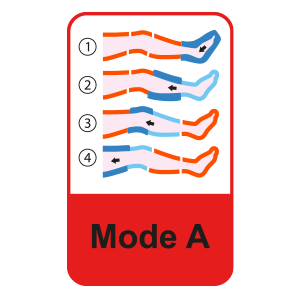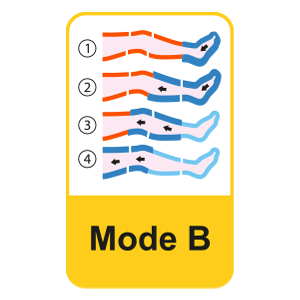Professional pressotherapy
What is pressotherapy?

Where it is most suitable
Prevention and therapy of venous and lymphatic disorders
Water retention
Lymphoedema
Venous insufficiency
Pre- and post-surgery
Sports medicine
Limb rehabilitation
Aesthetic medicine
Clinical studies on pressotherapy
Comparison of Intermittent Pneumatic Compression with Manual Lymphatic Drainage for Treatment of Breast Cancer-Related Lymphedema.
OBJECTIVE: To evaluate the efficacy of two different treatment combinations for lymphoedema (LE). Manual lymphatic drainage (MLD) combined with compression bandaging were compared with a treatment consisting of intermittent pneumatic compression (IPC) and lymphatic self-massage (SLD).
PROTOCOL: Both the group that received manual lymphatic drainage with compression bandages (Group 1, no. 15) and the group that received IPC and SLD (Group 2, no. 15), performed these treatments for lymphoedema every other day for 6 weeks. IPC was applied for a duration of 45 minutes per session with a pressure of 25 mmHg.
RESULTS: Both treatment modalities led to a significant reduction in total arm volume (12.2% reduction in Group 2 and 14.9% in Group 1) (p<0.001).

CONCLUSIONS: The different treatment combinations MLD + compression bandage or IPC + SLD are effective in the treatment of lymphoedema in patients undergoing mastectomy. The combination of intermittent pneumatic compression and draining self-massage is a preferable choice due to its daily applicability at home and cost-effectiveness.
With the different compression modes in our PRESSOTHERAPIAL devices, it is possible to treat problems related to the lymphatic system.
Observational retrospective study on the efficacy of sequential graduated intermittent pneumatic compression therapy of lower limb oedema.
OBJECTIVE: to evaluate the efficacy of sequential graduated intermittent pneumatic compression (SGIPC) in the treatment of lower limb oedema, independent of aetiology.
PROTOCOL: treatment was carried out on 90 subjects on both lower limbs (even if the oedema was localised on only one of them), with sequential intermittent pneumatic compression for one hour a day and using a pressure of 45 mmHg, for a total of 5 sessions.
RESULTS:
90% OF THE SUBJECTS: REDUCTION IN CIRCUMSTANCES ON AT LEAST 90% OF THE 2 POINTS BETWEEN THE FOOT AND THE CALF > 3 mm
100% OF SUBJECTS: DISAPPEARANCE OF LOWER LIMB PAIN
100% OF SUBJECTS: DISAPPEARANCE OF THE FEELING OF HEAVINESS IN THE LEGS
CONCLUSIONS: Graduated sequential intermittent pneumatic compression (SGIPC) is of considerable support in the treatment of lower limb oedema, regardless of aetiology.
With the different compression modalities available in our PRESSOTHERAPY devices, it is possible to treat limb oedema problems, regardless of the aetiology.
Effect of sequential pneumatic compression therapy on venous blood velocity, refilling time, pain and quality of life in women with varicose veins: a randomised control study.
OBJECTIVE: To evaluate the effects of sequential pneumatic compression therapy on venous flow, refilling time, pain level and quality of life in women with varicose veins.
PROTOCOL: 28 women were randomly divided into two groups. Both groups received treatment with lower limb exercises (5 days a week for 6 weeks). The patients in the STUDY GROUP also received 30 minutes per day of sequential pneumatic compression (5 days a week for 6 weeks).

CONCLUSIONS: Sequential pneumatic compression can be a valuable tool to improve venous blood flow and quality of life and to reduce pain in women with varicose veins.
With the different compression modalities in our PRESSOTHERAPY devices it is possible to treat venous return problems.
How to use it
Wear the accessories (boots, armbands or abdominal band) according to the area of the body to be treated and connect them to the device. If necessary, you can increase the circumference of the sleeves by connecting the extenders, which can be purchased as an optional accessory. You will be able to treat two (upper or lower) limbs and the abdomen at the same time, thanks to the dual connectors. Before starting therapy, you will be able to choose between three types of compression, set the treatment duration, adjust the pressure with which the accessories will inflate and select the active connectors.

Types of compression
The sleeve chambers inflate individually in the disto-proximal direction. When the next chamber begins to inflate, the previous one begins to deflate shortly afterwards, and so on for all chambers. This type of compression is called peristaltic compression and is particularly suitable to cool down limbs, either after training or at the end of a working day, and for reducing swelling induced by muscle microinjuries and water retention.

The sleeve chambers inflate two at a time in a disto-proximal direction. When the next chamber begins to inflate, the previous one begins to deflate shortly afterwards, always keeping two of them inflated. This type of treatment, which is always peristaltic, is especially indicated for the prevention of venous ulcers, chronic venous insufficiency and other disorders of the circulatory system.

The sleeve chambers inflate individually in the disto-proximal direction, remaining inflated as they pass to the next chamber. This type of compression is called sequential and is used as a true therapy, as in the case of lymphoedema, as it allows the reabsorption and outflow within the lymphatic and venular pathways of the liquid component of the oedema.

Why choose us?
The
device for professional pressotherapy

